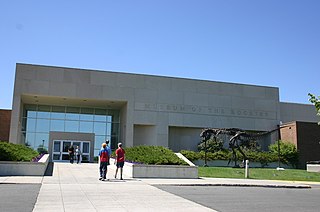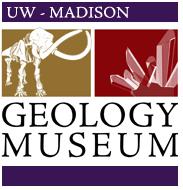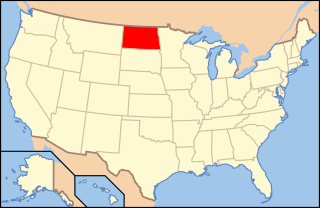
Dinosaur Provincial Park is a UNESCO World Heritage Site situated 220 kilometres east of Calgary, Alberta, Canada; or 48 kilometres (30 mi) northeast of Brooks.

Brachylophosaurus was a mid-sized member of the hadrosaurid family of dinosaurs. It is known from several skeletons and bonebed material from the Judith River Formation of Montana, the Wahweap Formation of Utah and the Oldman Formation of Alberta, living about 81-76.7 million years ago.

The Leicester Museum & Art Gallery is a museum on New Walk in Leicester, England, not far from the city centre. It opened in 1849 as one of the first public museums in the United Kingdom. Leicester Museum & Art Gallery contains displays of science, history and art, both international and local. The original building was designed by Joseph Hansom, designer of the hansom cab. It has been expanded several times, most recently in 2011.

Museum of the Rockies is a museum in Bozeman, Montana. Originally affiliated with Montana State University in Bozeman, and now also, the Smithsonian Institution. The museum is largely known for its Paleontological collections as well as having the largest collection of North American Dinosaur fossils in the United States. They also possess the largest Tyrannosaurus skull ever discovered, as well as the thigh bone of a Tyrannosaurus rex that contains soft-tissue remains. The museum is part of the Montana Dinosaur Trail and is Montana's official repository for Paleontological specimens.

The Wyoming Dinosaur Center is located in Thermopolis, Wyoming and is one of the few dinosaur museums in the world to have excavation sites within driving distance. The museum displays the Thermopolis Specimen of Archaeopteryx, which is one of only two real specimens of this genus on display outside of Europe.

The UW–Madison Geology Museum (UWGM) is a geology and paleontology museum housed in Weeks Hall, in the southwest part of the University of Wisconsin–Madison campus. The museum's main undertakings are exhibits, outreach to the public, and research. It has the second highest attendance of any museum at the University of Wisconsin–Madison, exceeded only by the Chazen Museum of Art. The museum charges no admission.

Sue, officially designated FMNH PR 2081, is one of the largest, most extensive, and best preserved Tyrannosaurus rex fossils ever found, at over 90 percent recovered by bulk.

"Stan", also known by its inventory number BHI 3033, is a Tyrannosaurus rex fossil found in the Hell Creek Formation in South Dakota, just outside of Buffalo in 1987, and excavated in 1992. It is the fifth most complete T. rex fossil discovered to date, at more than 70% bulk. In October 2020, the fossil was sold for $31.8 million at auction, making it at the time the most expensive dinosaur specimen and fossil ever sold. This record stood until July 2024, when the Stegosaurus fossil Apex sold at auction for $44.6 million. In March 2022, Abu Dhabi's Department of Culture and Tourism stated that they had acquired Stan and were planning on displaying the fossil at a new museum of natural history scheduled to open in 2025.

Tyrannosaurus is one of the most iconic dinosaurs and is known from numerous specimens, some of which have individually acquired notability due to their scientific significance and media coverage.
Tyler R. Lyson is an American paleontologist. He is the discoverer of the dinosaur fossil Dakota, a fossilized mummified hadrosaur. He has done significant research on the evolution of turtles and on the rise of mammals after the extinction of the dinosaurs.

The Dickinson Museum Center is and organization that preserves and presents history through a museum complex in Dickinson, North Dakota. The organization operates the museum center, which serves as a history museum for the city of Dickinson, Stark County, and Southwest North Dakota.

Albertonykus is an alvarezsaurid dinosaur from the Maastrichtian-age rocks of the Horseshoe Canyon Formation of Alberta, Canada. It is known from forelimb and hindlimb remains from multiple individuals. All but two of the specimens come from a bonebed dominated by Albertosaurus, located at the top of Unit 4 of the Horseshoe Canyon Formation, dating to ~68.5 million years ago.

Paleontology in North Dakota refers to paleontological research occurring within or conducted by people from the U.S. state of North Dakota. During the early Paleozoic era most of North Dakota was covered by a sea home to brachiopods, corals, and fishes. The sea briefly left during the Silurian, but soon returned, until once more starting to withdraw during the Permian. By the Triassic some areas of the state were still under shallow seawater, but others were dry and hot. During the Jurassic subtropical forests covered the state. North Dakota was always at least partially under seawater during the Cretaceous. On land Sequoia grew. Later in the Cenozoic the local seas dried up and were replaced by subtropical swamps. Climate gradually cooled until the Ice Age, when glaciers entered the area and mammoths and mastodons roamed the local woodlands.

Paleontology in the United States can first be traced to the Native Americans, who have been familiar with fossils for thousands of years. They both told myths about them and applied them to practical purposes. African slaves also contributed their knowledge; the first reasonably accurate recorded identification of vertebrate fossils in the new world was made by slaves on a South Carolina plantation who recognized the elephant affinities of mammoth molars uncovered there in 1725. The first major fossil discovery to attract the attention of formally trained scientists were the Ice Age fossils of Kentucky's Big Bone Lick. These fossils were studied by eminent intellectuals like France's George Cuvier and local statesmen and frontiersman like Daniel Boone, Benjamin Franklin, William Henry Harrison, Thomas Jefferson, and George Washington. By the end of the 18th century possible dinosaur fossils had already been found.

Anzu is a monospecific genus of caenagnathid dinosaur from North Dakota, South Dakota and Montana that lived during the Late Cretaceous in what is now the Hell Creek Formation. The type species and only species, Anzu wyliei is known from numerous skeletons that preserve cranial and postcranial elements. It was named in 2014 by Matthew C. Lamanna, Hans-Dieter Sues, Emma R. Schachner, and Tyler R. Lyson.

Dippy is a composite Diplodocus skeleton in Pittsburgh's Carnegie Museum of Natural History, and the holotype of the species Diplodocus carnegii. It is considered the most famous single dinosaur skeleton in the world, due to the numerous plaster casts donated by Andrew Carnegie to several major museums around the world at the beginning of the 20th century.

The Mace Brown Museum of Natural History is a public natural history museum situated on the campus of The College of Charleston, a public liberal arts college in Charleston, South Carolina. With a collection of over 30,000 vertebrate and invertebrate fossils, the museum focuses on the paleontology of the South Carolina Lowcountry. Admission to the museum is free, and donations are welcome. The museum has the holotype specimens of Coronodon, Cotylocara, and Inermorostrum, as well as the reference specimen of Ankylorhiza tiedemani

Big John is a fossilized Triceratops horridus skeleton discovered in South Dakota's Hell Creek geological formation in 2014. It is the largest known Triceratops skeleton, according to the team that assembled the fossil. Big John's 2021 auction price of €6.6 million made it the most expensive Triceratops skeleton; its high price signaled increasing demand for dinosaur fossils among private collectors and prompted discussion about the drawbacks of private fossil ownership for scientific research.
Victoria is a specimen of the species Tyrannosaurus rex recognized for its well-preserved and nearly complete skeleton, making it the second most complete T. rex finds in recent history. Victoria got her name in the lab in Victoria, British Columbia, where it was studied and restored.


















